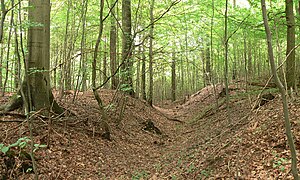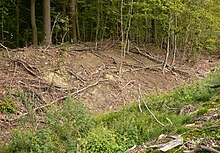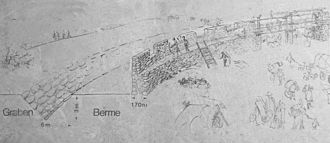Heisterschlösschen
| Heisterschlösschen | ||
|---|---|---|
|
Ditch the ramparts, on the left the castle area |
||
| Alternative name (s): | Hünenschloss, Heisterburg | |
| Creation time : | around 800 to 1200 | |
| Castle type : | Hilltop castle | |
| Conservation status: | Remnants of walls, walls, ditches | |
| Place: | Beckedorf | |
| Geographical location | 52 ° 20 ′ 6 " N , 9 ° 18 ′ 47.6" E | |
|
|
||

The Heisterschlösschen , also called Hünenschloss or Heisterburg , is the castle stables of an early medieval ring wall , the remains of which are on the Heisterberg near Beckedorf ( Schaumburg district ) in Lower Saxony . The Wallburg on the ridge of a foothill of the Bückeberg probably served as a refuge for the population. An excavation carried out in 1893 brought hardly any finds and placed the complex in the 9th – 12th centuries. Century a.
location
The former fortification is located in a wooded area on the northern edge of the Heisterberg, a foothill of the Bückeberg. It is located about 500 m south of Beckedorf . The rampart was built on a ridge sloping slightly to the north. In the west it leans against a canyon-like, 15 m deep stream that offered it natural protection.
excavation
An archaeological investigation of the Heisterschlösschen took place in 1893. In doing so, around 30 excavation cuts were made in the ground, especially in the area of the ramparts, which were up to 2.5 m deep. Investigations inside the ramparts, which could give indications of an earlier settlement, were not carried out. There were hardly any found objects, so that a chronological classification of the facility was only possible due to its construction.
description
The core of the fortification is a circular wall 65 m in diameter. Today it is only 1.5 m high. This is likely to be due to the removal of the stone material in earlier times for buildings in the nearby villages.
During the excavation of 1893 it was found that the wall had a 1.7 m thick, front wall using the two-shell technique. The outer fronts consisted of broken sandstone and were built with the help of lime mortar, while the space in between was filled with loose stone material. During the use phase, the wall was probably several meters high. In the wall there were also the remains of two approximately 7 m wide gates, which were possibly provided with a wooden superstructure . The rampart is surrounded by a berm and a 3 m deep and 6 m wide pointed ditch , which was laid out with stone slabs.
Interpretation of use
Nothing has historically been handed down about the builders and users of the facility. Because of its size and structure, the ramparts could have served the population as a refuge in times of war and danger . The lack of funds during the excavation speaks against permanent residential use. But there are also indications that it was a noble residence of the Lords of Riepen, who were first mentioned in 1124, who later became Counts of Roden.
There could also be a relationship between the facility and Hellweg . Coming from the Rhineland, it leads past Beckedorf as a west-east trade route. Its earlier course corresponded roughly to today's B 65 . It is believed that a branch of the Hellweg passed the ramparts and led as a high path over the Heisterberg and the Bückeberg.
Similar fortifications in the vicinity
- In the plane:
- Isenburg near Barsinghausen -Landringhausen
- Düsselburg near Rehburg
- Lüningsburg near Neustadt am Rübenberge
- In height:
- Heisterburg near Lauenau - Feggendorf
- Wirkesburg near Lauenau-Feggendorf
- Barenburg near Eldagsen
- Kukesburg near Springe -Altenhagen
- Bennigser Castle near Bredenbeck- Steinkrug
- Sachsenwall near Nordstemmen
Fortifications of this kind were originally regarded as Saxon or Heinrichsburgen by archaeological research . The more recent research assigns the structures in the area of the Central Weser and the Leine to a period from 8th to 12th centuries. Century too. Due to the lack of settlement, the facilities are likely to have only been used sporadically and have served as refuges. In the case of the facilities in the Deister area (Wirkesburg, Bennigser Burg, Heisterschlösschen) it is typical that they were built on sloping mountain ridges and near a stream.
literature
- Hans-Wilhelm Heine : Das Heisterschlösschen near Beckedorf in: Guide to prehistoric and early historical monuments, Volume 49, Part II Excursions, Mainz 1981
- Hans-Wilhelm Heine: The prehistoric and early historical castle walls in the district of Hanover , 2000, Hanover, ISBN 3-7752-5645-8 , pp. 150–152.
- Hans-Wilhelm Heine: Schaumburger Land - Burgenland , in the series Guide to the Prehistory and Early History of Lower Saxony (29), Oldenburg, 2010, published by the Lower Saxony State Office for Monument Preservation and the Archaeological Commission for Lower Saxony , ISBN 978-3-89995-673- 3
Web links
- Entry by Stefan Eismann on Heisterschlösschen in the scientific database " EBIDAT " of the European Castle Institute
- Description and sketch of the location of the facility ( memento from November 7, 2014 in the Internet Archive )
- Heisterschlösschen in: Castles around 1000 between Mittelweser and Leine (PDF, 500 kB)



